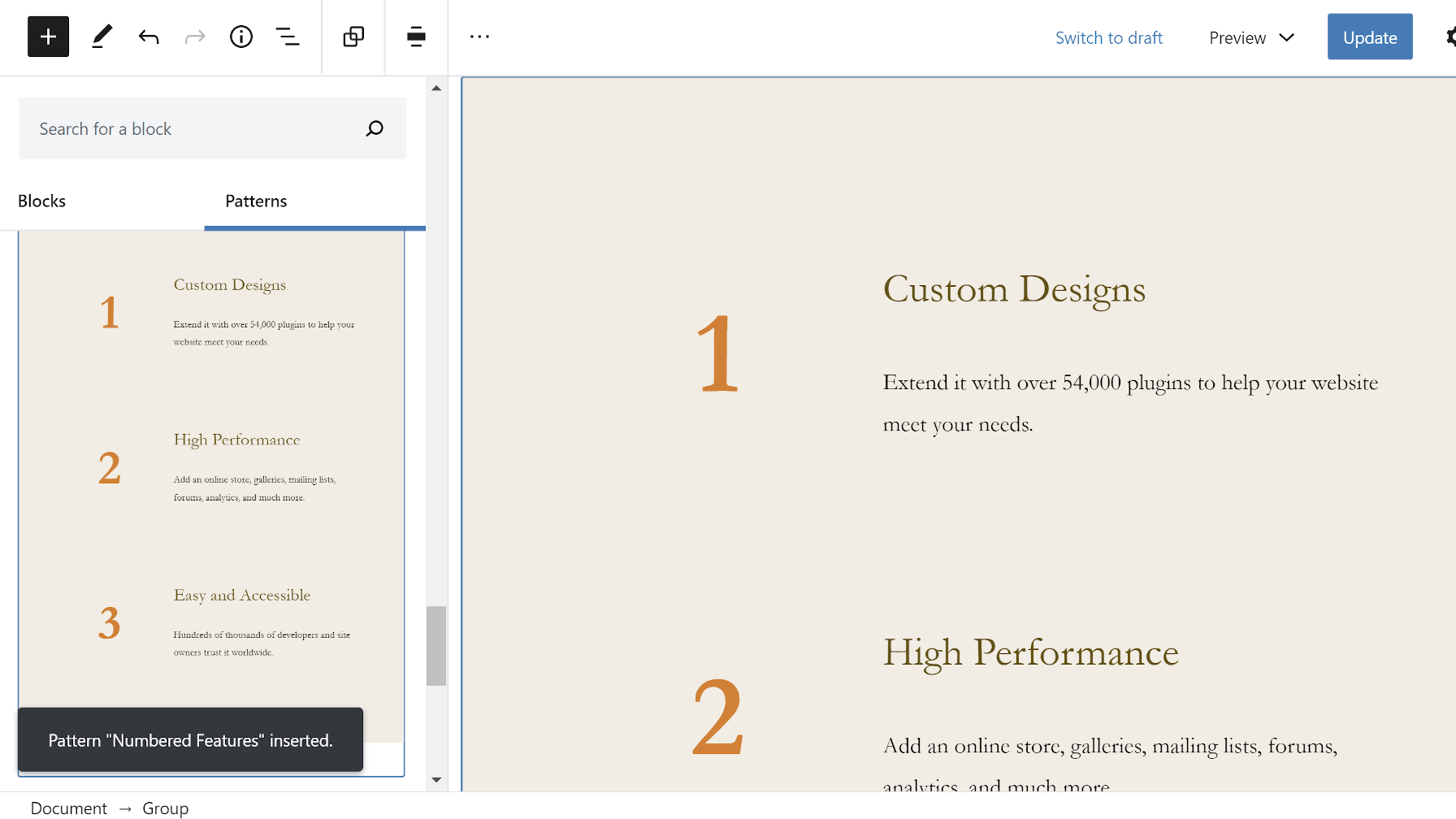
The first beta release of WordPress 5.5 is mere days away. This test release is expected to ship on July 7, and it carries with it a slew of new features that have primarily been developed between Gutenberg 7.6 and 8.5. One of the more pressing decisions the development team has to make is which block patterns to include in the final release.
For the uninitiated, block patterns are a predefined configuration of multiple blocks. They provide end-users a way to quickly insert more complex layout patterns into the editor. Instead of piecing together multiple blocks, nesting them within the proper group container, and getting everything perfect, the user merely searches the pattern library and selects the pattern they prefer. It is then inserted into the editor where the user can edit the content, such as altering the default text or changing the media.
It is an ingenious solution to an otherwise complicated problem. It also has the potential to move the block editor somewhat in the realm of actual page building.
For end-users, it could mean no longer spending hours learning how to recreate that pretty demo page that sold them on installing a specific theme. No more slogging through tutorials that feel like they were written for people with comp-sci degrees. Just click some buttons and watch the magic happen.
I have said that block patterns will change everything. I was patiently enthusiastic about the API when it first landed in Gutenberg 6.9. I was downright giddy to play around with the first patterns that shipped with Gutenberg 7.7.
Outside of a few that have made their way into Gutenberg in recent versions, I have not been particularly ecstatic about the default patterns the development team has included. In my mind, most were always test cases, patterns meant to iron the bugs out of the system. Then, some of the world-class designers we have in the WordPress ecosystem would design a handful of solid default patterns. I fully expect theme authors to push the limits of the system, but I was hoping that WordPress would use this opportunity to showcase what the block system can really do.
The closest that Gutenberg has come to shipping useful, modern block patterns have been its Testimonials, Numbered Features, and Features and Services patterns. These three were initially set on the chopping block (Testimonials have since been re-added), ready for the ax before WordPress 5.5 goes out to millions of users who could use such features instead of the tired and old solution of theme options. If these go, block patterns will likely land with a thud instead of the flash and bang the feature could make. We need to get users excited. We need to inspire the multitude of theme authors to build something greater — hey, look what you can do with this feature. Our development community needs to stand upon the shoulders of giants rather than feel like they are building from scratch.
We should not be afraid to be bold with the “1.0” of block patterns.
For the most part, with the latest patch on a ticket that is currently in flux, the team has nixed all but the least mundane patterns.
Block patterns are meant to represent common design layouts and configurations that we see around the web today. However, the current crop of patterns does not do justice to the idea. From the developer end of things, it is a powerful API. From the user side of things, it will feel like another half-baked plan to push in an unfinished feature before the deadline.
Maybe I am impatient. Maybe I need to get on board the ship-early-and-iterate-often train. But, the API has been in Gutenberg since November 2019. It is hard not to feel a little disappointed at the potential removal of the most opinionated patterns. They were the ones that I was eagerly awaiting to use. We can already easily put two images, columns of text, or buttons next to each other. The proposed patterns to ship with 5.5 do not feel like they will help users build the type of complex layouts the feature was meant to solve.
My rallying call, my plea to include some patterns with a little pizzazz in WordPress 5.5, might be cutting it close to the 11th hour. However, anyone eagerly awaiting this feature may have been as blindsided as I was yesterday when the pull request came down the pipeline to remove all but three basic patterns.
I want the narrator in the upcoming WordPress 5.5 release video to have a bit of pep in his voice instead of trying to give the hard sell on sticking two images next to each other.
I am not asking for complex pricing tables, a restaurant menu, or — God, forbid — a slider pattern. Those things are a bit more niche and not suitable for core. There is some middle ground we can meet, offering something of a bit more substance. And, if we cannot meet that middle ground, is the feature ready?
I’m the last person to suggest pulling the feature from the release, so I won’t venture down that dark path. I want block patterns. I want them now.
I do question whether we should ship such basic patterns with most users having to wait months for anything more useful. That’s unless their theme authors are generous enough to push out some new patterns between the major release cycles.
I am just a WordPress user asking to be amazed. Whet our appetites for a future where block patterns are everything.
What patterns would you like to see ship with WordPress 5.5?
Does WordPress 5.5 update expand the content management system’s auto-updating capabilities to themes and plugins??